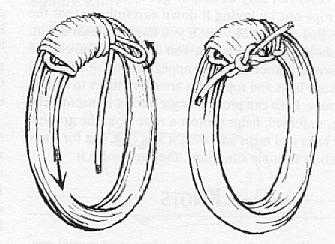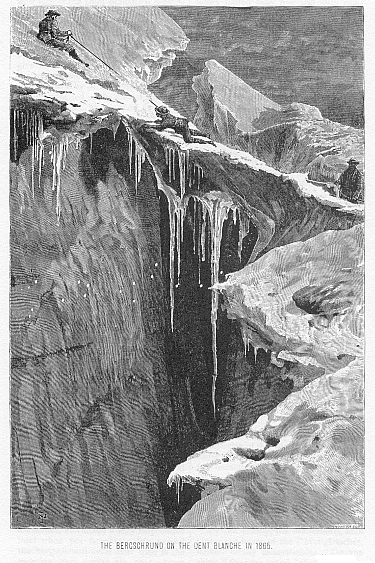 ™
™TRADITIONAL MOUNTAINEERING
™
www.TraditionalMountaineering.org
™ and also
www.AlpineMountaineering.org
™
 ™
™
FREE BASIC TO ADVANCED
ALPINE MOUNTAIN CLIMBING INSTRUCTION™
Home
| Information
| Photos
| Calendar
| News
| Seminars
| Experiences
| Questions
| Updates
| Books
| Conditions
| Links
| Search
![]()
Jim Frush, alpine climber and President of The American Alpine Club confirmed my feeling that the coiled mountaineers rope is the symbol of our sport
- the shared companionship of the adventure of the climb.
"In selecting a rope for the mountains, you've got a short list of critical things to consider", states Mark Twight on page 133 of his book "Extreme Alpinism".
Selecting the rope system that is best for the terrain and the style of the climb is first:
a super light twin rope system for ice climbs, a light single rope for glacier travel, a light durable fatter rope for loose rock and sharp flakes and so on.
Color and price should be at the bottom of the list, notes Mark Twight.
Different major brands of ropes vary significantly in weight for the same size of rope, depending on its design goals such as dry treatment,
sheath durability, number of falls it is designed to take, the stretch factor and so on. The dry treatment can be critical since a wet rope is far heavier
and less strong than a dry rope. The durability of the sheath is affected by the weave - single or double pick - which in turn affects the handling
characteristics.
Perhaps the best choice for the weekend climber in the Cascades is an 8.5-mm to 9-mm double dry 60-m climbing rope
from a major manufacturer. Heavier ropes of 10.5-mm and 11-mm may be best for the crags at Smith Rock State Park.
This recommendation is based on the use of the rope for short easy leader belays and primarily for upper belays and fixed ropes
for followers on fourth-class routes. Fifth class rock climbing in the mountains may require other critical considerations.
Traditional Mountaineers carry the rope made up in the
Mountaineers Coil. The rope so carried, is always available when the going
gets dicey, it is not crammed into someone's summit pack sized to the season and
it can be handed off easily to the short or tall climber as each does his or her
share of "lugging the beast". Yes, there are newer methods of
"coiling" the rope.
The weekend climber must know how to travel safely with rope alone, how to construct an anchor system if required, how to tie-in without a harness,
how to belay and rappel quickly and safely with rope alone.
Known fourth-class routes should require additional personal gear, simple,
lightweight harnesses such as the Black Diamond Alpine Bod Harness, prussic
loops and a few light wire-gate biners and light locking biners for certain
uses. These "easy" fourth-class routes are common in the Cascades on Mt.
Washington, Three Fingered Jack, North Sister, Mt. Jefferson and others where
the objective dangers and exposure are significant and sadly, deaths have
occurred.
Your leaders can bring a few sewn slings and longer runners, some chunky hexentrics and the skills of simple anchor construction. The rope must be clearly attached to the mountain with the anchor system. All anchor systems must be "SERENE":
Secure, Equalized, Redundant, and
designed for No Extensions if one of the redundant anchor points should fail.
The mountaineer’s rope is a tool designed to anchor climbers to the mountain by
using several of many possible techniques. An anchor system must be built from
securely placed gear, backed-up redundantly, equalized, providing for no extensions if
part of the redundant system should fail. When the rope is attached to the rock,
snow or ice using anchor and protection techniques, a belayer is needed to make
constant adjustments to be
sure there is little or no slack in the rope running to the climber so as to avoid shock-loading the
anchor system. A belayer who is
personally and correctly attached to the mountain, can belay the climber
from the belayer's harness by using a friction belay device or by his body alone. The belay can also be made
using one of several types of friction belay devices, directly off such a “SERENE”
anchor system with the belayer located above the belay device, separately anchored to the mountain.
Study "Mountaineering, the Freedom of the Hills", 8th Edition
Using the rope and other simple gear as described requires some study, learning from mentors and practice with companions. Snow climbing techniques derive from rock techniques with additional simple tools. Remember, the object of the sport is to return safely to the trailhead after an adventure. And, don't forget your
climbing helmet in the crumbling Cascades!
--On Belay! Bob Speik
Copyright© 1995-2015 by Robert Speik. All
Rights Reserved.

The Mountaineers' Coil
from Mountaineering, The Freedom of the Hills
![]()
![]()
![]()
About Alpine Mountaineering:
The Sport of Alpine Mountaineering
Climbing Together
Following the Leader
The Mountaineers' Rope
Basic Responsibilities
![]() Cuatro Responsabiliades Basicas de Quienes Salen al Campo
Cuatro Responsabiliades Basicas de Quienes Salen al Campo
The Ten Essential Systems
![]() Los Diez Sistemas Esenciales
Los Diez Sistemas Esenciales
